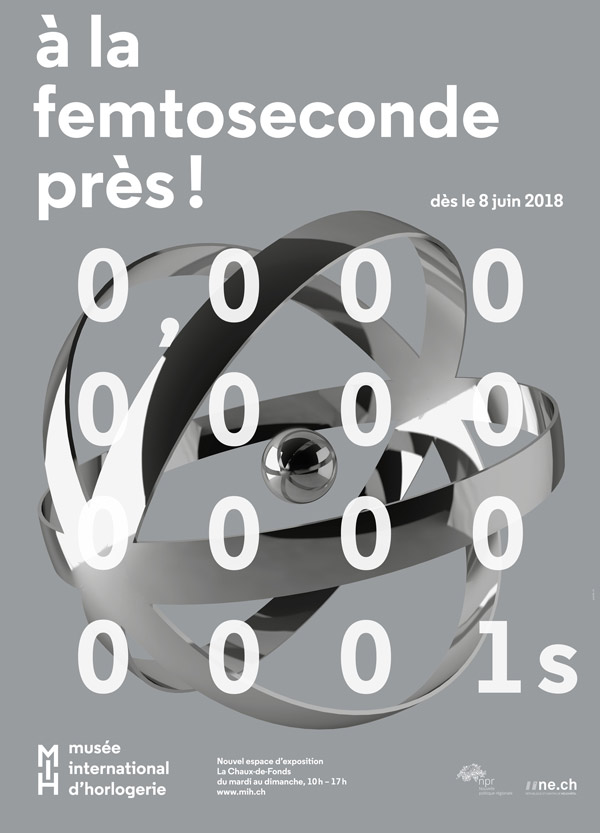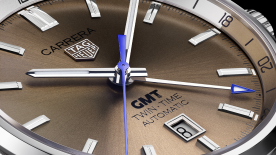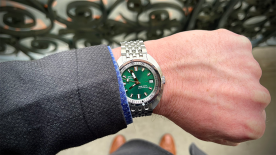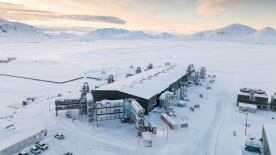How long does one second last? Who decides what time it is? The scholarly quest for precision has been at the heart of watchmaking innovation since the 17th century. Oscillators are key to developments in this field: the pendulum, the spring balance and, later, quartz, have all increased timekeeping accuracy. From the Second World War, physicists took over from astronomers and horologists in the pursuit of accurate time measurement. From 1967, the second was no longer defined via astronomical observations such as the passage of the sun across the zenith, but by measuring a microscopic phenomenon: the oscillation of caesium atoms.
The new MIH exhibition space, which will be open to the public from 8th June, is entitled To the nearest femtosecond! A femtosecond, or 0.000000000000001 of a second, corresponds to the imprecision in the ticking of a modern atomic clock. That equates to one second every 3 million years!
The exhibition on display within the architectural extensions to MIH, the Gallery and the Belfry, looks at the theme of extreme precision from three different angles:
1. The evolution of precision from mechanical clocks to atomic clocks, via electromechanical pendulum and quartz clocks.
2. The operation of the various types of atomic clocks.
3. The various applications of these clocks in daily life, and in the field of scientific research, symbolised by a model of the Galileo satellite, spanning four metres and suspended ten metres above the ground.
To mark the opening of this new exhibition space, MIH has revamped the reception for this benchmark exhibition. Visitors will now be able to enjoy commentary from Father Time himself! In two clips, each lasting three minutes, this special guide provides the keys to understanding the history and mechanics of timekeeping, and atomic clocks in particular.
As the quadrillionth of a second is such a complex and abstract subject, MIH has developed different ways of presenting it to its target audiences. In addition to the standard trilingual texts (fr-de-en) with differentiated reading levels, the visitor can also use an audio guide in five languages (fr-de-en-it-es) designed to provide clear yet detailed information on the complex objects on display. The younger public and their families are also catered for. Kids can get into character by slipping on a physicist's white coat and following the exhibition using a guide designed as a textbook.

The exhibition organised by MIH – a City of La Chaux-de-Fonds institution – is supported by the Canton of Neuchâtel and the Swiss Confederation through its new regional policy known as the NPR. More than just a themed exhibition, this new space also provides an additional cultural and tourist attraction to draw in both international visitors and the many locals working in the fields of research, development, industrialisation and commercialisation of atomic clocks in Neuchâtel (Laboratoire Temps-Fréquence, University of Neuchâtel, Centre Suisse d’Electronique et de Microtechnique CSEM, Oscilloquartz, Spectratime, T4Science).
As a mark of the current interest in this hot topic, the 18th European Mars Convention, organised by the Mars Society Switzerland in 2018, will take place from 26th to 28th October at MIH on the theme of Robots and Man on Mars - the role of time. This event will provide the public with an opportunity to hear from astronaut Claude Nicollier.
Musée international d'horlogerie (MIH)
Rue des Musées 29
CH - 2301 La Chaux-de-Fonds
www.mih.ch
Public opening: 8th June at 10:00, standard MIH opening hours (Tues-Sunday, 10:00-17:00)
Entrance to the "To the nearest femtosecond!" exhibition is included in the museum entrance price





